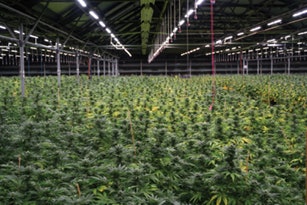1. How do I know if a greenhouse will work in my region?

The first thing to do is to determine what natural light levels you receive in your region. Daily Light Integral (DLI) exists specifically for use by greenhouse growers, because clouds and other atmospheric interference make it difficult to take accurate light intensity readings (µmol/m2/s) and infer how much total light the plant is getting over one day. Further complicating the issue is how light intensity gradually increases, peaks and decreases as the sun rises and sets. Therefore, DLI covers the number of photons (moles) accumulated in one day (see equation). For example, in the summer you may have an average light intensity level of 800 µmol/m2/s and a day length of 16 hours. This equals a DLI of ~46 moles/day ((800*3600*16)/1,000,000). Properly understanding this metric is key to deciding between a greenhouse or an indoor grow.
2. Why should I consider installing supplemental lighting in a greenhouse?
A greenhouse allows you to take advantage of the natural light in a region. However, this does not mean the greenhouse should be restricted to only natural sunlight. An experienced grower knows crop consistency and predictability are key for production efficiency. Therefore, greenhouse producers need to supplement to maximize yield year-round, particularly when natural light levels are low, e.g., in the winter to ensure seasonality doesn’t ruin your average annual yield predictions.
3. What is one thing I should consider when designing a greenhouse facility?

Form factor. The structural form of a lighting fixture can have a significant impact on the amount of shading that can be produced by these fixtures. Make sure to choose a fixture that fits well under your truss, shade cloth, etc. without shading plants from natural sunlight, which of course defeats the entire purpose of using supplemental lighting.
4. How does lighting affect product quality and yield?
Lighting is a complicated topic as it influences both plant growth and plant development. At a top level, light intensity controls the pace of both plant growth and development, while photoperiod manipulates the plant development stage. Light quality determines how effective a photoperiod response is and even determines plant growth attributes, such as compactness, branching and stretch. With environmental precision, use light intensity to push the limits of what you currently define as maximum yield and crop quality.

5. Any tips on what to consider in adjusting my lighting strategy?
There are many things to consider, but the first piece of advice I give is to try not to decide based solely on budget. Choose the solution which fits your criteria (form factor, spectrum and light intensity). If price becomes an issue, start small and prove the potential of the technology to yourself. Allow the revenue to be generated and then invest in what you have proven works.














